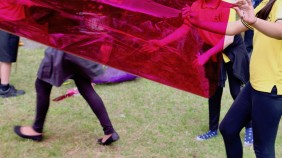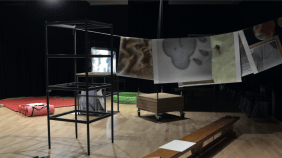Odd Labs
Emergent spaces of cross-disciplinary research.
The project
THE PROJECT
The ‘Odd Labs’ were times and spaces held as part of the Odd Project’s research design. They were intended as an emergent space for correspondences between researchers, data, and the multiple sites and conditions that the Odd Project addressed and were shaped by.
The team used a variety of methods for ‘correspondences’ (Ingold, 2017) between and ‘re-turning’ of research material (Barad, 2014).
Activities in the lab drew on and interrogated the different disciplinary approaches of the team, from art practices to co-production with children and teachers. Each lab looked and felt quite different, and offered the research team an opportunity to test the possibilities and limitations of thinking through doing, collectively.
Gallery of images
More information
The labs generated artefacts, temporary installations and micro-performances. Reflections from the labs exist as audio files, partial transcriptions, field notes, drawings and photographs of remnants of encounters.
Data was sometimes ‘remixed’ (Claisse and Sun, 2015), helping the team to process and share experiences in the field. Using different methods sometimes helped the team to acknowledge their own subjectivities.
To date, the labs have included:
-
Re-turning/Worrying Materials
In this lab, Dr Jo Ray invited each of the researchers to contribute materials found from their research in school.
Jo received field notes, drawings, written reflections, and requests for materials or substances found in a school environment.
With the materials, she made an immersive installation-like environment and invited the team to revisit their research together.
The researchers were invited to interact with and ‘remix’ the material.
By being all together during the making process, new insights about the experiences of being in school and researching with the children emerged.
The pleasures and discomforts of working in this way together also raised different perspectives about the possibilities of research methods in the fields of education, anthropology, and art practice.
-
Research Inheritances
One of the aims of the project is to understand how a research collective can co-produce new perspectives on school experiences of ‘feeling different’, and generate practices of inclusion more attuned to the complex nuances of such experiences.
With the objective of supporting the research team to reflect on their own experiences, perspectives, and positions as researchers, and how this might inform practices on the Odd Project, Dr Becky Shaw (Sheffield Hallam University) and Dr Jo Ray devised a lab.
This lab investigated how making something wearable might generate new insight and/or enable the team to communicate with one another in new ways.
This was informed by the practices of children in school and their own experiences of making as art practitioners.
-
School-as-lab
Professor Kate Pahl and Steve Pool facilitated a lab in a school in collaboration with the children and teachers.
This focused on the practices of the children, listening to their experiences through their creative work and through experiencing their modes of being in the space of school.
The Odd team were invited to school for a screening of film works made by children during their time working with Kate and Steve.
This was followed by an expansive playful session on the grounds of the school, in which children, teachers, teaching assistants and the Odd team transformed elements of the environment.
This was done by making experimental structures and material interventions with coloured films, fabrics, tape, and structural components such as branches, sticks and bamboo canes.
New kinds of space were created in this collaborative and unplanned process.
-
Sound Lab
Professor Amanda Ravetz and Dr Jo Ray convened a lab based on the theme of sound, with the aim of considering school through aural encounters.
Each researcher was invited to share their experience of the auditory in research in school and presented field notes, reflections, audio recordings and films made in response to sound.
Amanda and Jo invited the team to trial a process inspired by Foley art practices, using rudimentary materials often found in classrooms such as sand, plastic cups, wooden blocks and paper to make an improvised soundtrack to piece of silent video footage made by Amanda during her time in Position of Child at Alma Park school.
Conclusion
The shared commitment of the research collective to ‘feeling different in the world of education’ has generated opportunities to grapple with delicate methodological tensions, infectious mixtures and complex interwoven entanglements.
The Lab has offered alternative ways to consider data as unfixed, as a live material.
Discussing modes of escape from the regimented time of the institution, Jill Stoner lists ‘tapping, scratching, reading, writing, gazing and pacing’ (Stoner, 2012). These exploratory, improvisatory and open-ended tendencies arise out of pleasure, curiosity, conversation or rest.
The ‘worrying’ of research matter with brain and body in the lab, generates a space of intimate research that brings us close to the experience of others through practice.
Research Associate Dr Jo Ray presented a paper at the British Educational Research Association Conference 2019, exploring the role of the lab and the space-time it held for researchers to think and feel their way into the research differently.
The team have reflected that there are equivalents in the space of the lab, which is something slightly different from the usual space of research, to the kind of alternative space the Odd Project sometimes held in school: the spaces at the edge, or between.
Related project streams
Contact us
Contact us
If you have any questions about Odd Labs, please contact Professor Rachel Holmes.




